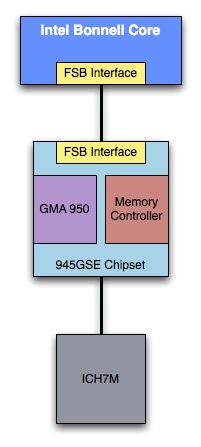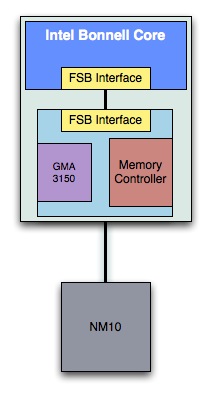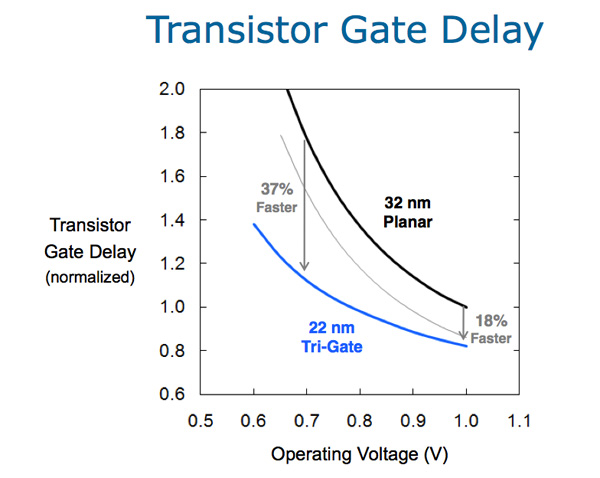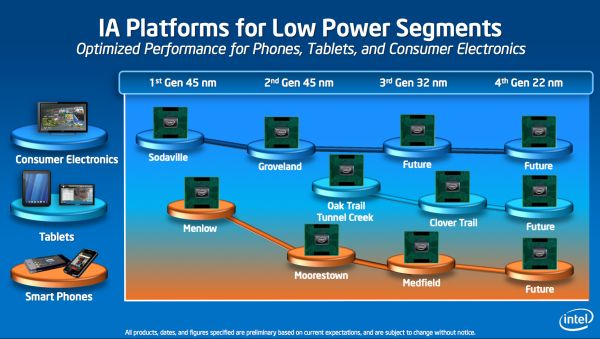Intel's Silvermont: A New Atom Architecture
by Anand Lal Shimpi on May 12, 2011 6:18 PM EST- Posted in
- CPUs
- Intel
- Atom
- Silvermont
- SoCs
Brooke Crothers broke a very important story today - he published the name Silvermont. Atom's first incarnation came to us in 2008 as a Pentium-like dual-issue in-order microprocessor. The CPU core was named Bonnell, after the tallest point in Austin at around 750 feet. Small mountain, small core. Get it?
Bonnell and the original Atom were developed on a 5-year cadence, similar to how Intel ran things prior to the Core 2 revolution (the P6 to Netburst/Pentium 4 move took 5 years). With the original chip out in 2008, five more years would put the next major architecture shift at 2013, which happens to be exactly when the Cnet report mentions Silvermont will be introduced.
When I first met with the Atom design team they mentioned that given the power budget and manufacturing process, the Bonnell design would be in-order. You get a huge performance boost from going to an out-of-order architecture, but with it comes a pretty significant die area and power penalty. I argued that eventually Intel would have to consider taking Atom out of order, but the architects responded that Atom was married to its in-order design for 5 years.
and_PlatformControllerHub_package2_sm.jpg)
Intel's Moorestown - same Atom core, just more integrated
Since 2008, Atom hasn't had any core architecture changes. Sure Intel integrated the GPU and memory controller, however the CPU still communicates with both of them over an aging FSB. The CPU itself remains mostly unchanged from what we first saw in 2008. Even Intel's 32nm Atom due out by the end of this year doesn't change its architecture, this is the same dual-issue in-order core that we've been covering since day 1. The 32nm version just runs a bit quicker and is paired with a beefier GPU.
|
Intel Atom "Diamondville" Platform 2008
|
Intel Atom "Pine Trail" Platform 2009-2010
|
 |
 |
Silvermont however changes everything. It is the first new redesign of the Atom architecture and it marks the beginning of Atom being on a tick-tock cadence. Say goodbye to 5 year updates, say hello to a new architecture every 2 years.
Given what Intel said about Atom being in-order for 5 years, I think it's safe to say that Silvermont is an out-of-order microprocessor architecture. The other big news is that Silvermont will be built using Intel's 22nm transistors. What may not have been possible at 45nm gets a lot easier at 22nm. Assuming perfect scaling, a chip built on Intel's 22nm process would be a quarter the size of the same chip built at 45nm. With Apple paving the way for 120mm2+ SoCs, Silvermont can be much more complex than any Atom we've seen thus far.

Intel's 22nm transistors offer huge gains at low voltages, perfect for Silvermont
By 2013 Intel's 22nm process should be very mature, which maintains Intel's sensible design policy of only moving to a new architecture or a new process, but not both at the same time in order to minimize risk. With 22nm debuting in Ivy Bridge at the end of this year (with availability sometime in 1H 2012), this puts Silvermont at a full year behind
Intel isn't talking core counts at this point, but for 2013 I'd expect both monolithic dual and quad-core variants. If we use history as any indicator, Intel will likely drop the FSB in favor of a point-to-point bus interface between Silvermont and its cohorts.
The big question is about GPU technology. Intel has historically used GPUs licensed from Imagination Technologies in its smartphone/tablet/MID line, while opting for its own in-house GPU solutions for nettops/netbook versions of Atom. At 32nm the rumor is that may change to an all Imagination lineup, but at 22nm I do wonder if Intel will keep licensing 3rd party IP or switch to its own.
Intel is expected to announce more details about its Atom roadmap at an analyst event next week. While the expectation is that we'll see Atom based Android smartphones this year, I'm personally quite interested in Silvermont.
Single and dual-core 32nm Atom designs should be able to hold their own in a world dominated by dual-core ARM Cortex A9s, but an out-of-order Atom on an aggressive roadmap is something to be excited about.
By 2013 we should be seeing smartphones based on Tegra 3 and 4 (codename Wayne and Logan) and ARM's Cortex A15. GPU performance by then should be higher than both the PS3 and Xbox 360 (also implying that Silvermont needs Sandy Bridge level graphics performance to be competitive, which is insane to think about).











53 Comments
View All Comments
ProDigit - Friday, May 13, 2011 - link
To keep compatibility!
There are a lot of programs ran on older and slower computers (like netbooks).
It'd be good if those old instructions would be removed from desktop processors, not from these slower machines.
MMX is rarely used anymore when SSE(2/3/4) is available.
iwod - Saturday, May 14, 2011 - link
To keep compatibility of what? Smartphone Apps? There are NO x86 smartphone apps!.That is why Intel should take this chance to re engineer x86.
ProDigit - Friday, May 13, 2011 - link
It all sounds so nice, out of order, but by doing that you essentially get a celeron processor.I figure intel could finally get to an "out of order" system because the 22nm processors would have the power envelope to do this!
Problems with 45nm designs where that the TDP was too big to fit them in netbooks and tablets.
If I where Intel, I would keep on using an 'in order' processor, to maximize battery life.
Essentially the new gen Atom processor would have slightly increased performance (about 20-30%) together with a ~50% more battery consumption. Give or take with a die shrink the battery consumption would be about 10% more than current Atom processors (in other words, ~10 hours of battery life become ~9;,, 5 hours become ~4,5.
The difference is neglegable, due to the increase in performance.
In other words, the step will be about as big as jumping from the N270 processor to the N475,or from the N450 to the N550.
Not too noteworthy.
If intel would keep their processors 'in order', they would gain battery life; compensate weakness by allowing dynamical overclocks, (turbo boost), and you'd have a processor that operates like a celeron (faster in some cases),with the power envelope coming very close to ARM territory; ON WINDOWS!
The news for Out of order technology is a blow to my face, and makes me the more resolute to go for the 32nm Atom processors released by the end of this year!
Out of order technology only benefit gamers and those who compress movies, or do heavy computing.
For viewing webpages and checking mails in order technology is all you need!
I think they are targeting the wrong market here!
People rather would push a celeron or ULV Core2duo in their netbooks, than an underpowered atom processor!
ProDigit - Friday, May 13, 2011 - link
...That is, an underpowered atom processor that has a TDP of an underclocked but higher performing C2duo or celeron.L. - Monday, May 16, 2011 - link
Errr .. wtf ?aren't ulv c2d + gpu much worse than brazos in netbook use ??
Jaybus - Monday, May 16, 2011 - link
Well, the proposed move to OoOE is just speculation, of course. For a higher performance tablet or netbook, it would make more sense to shrink the Core i5-2437M, which is already at 17 W TDP at 32 nm, So, I'm not so sure the new Atom will indeed move to OoOE. Wouldn't make sense. Atom and ARM are not in the same league as Core Mobile, either in performance or price. This would appease those for whom "good enough" is NOT good enough. We've heard the "good enough" argument for many years. But good enough for what? Good enough for how long?dealcorn - Friday, May 13, 2011 - link
Looking at its capital budget for fabs, dividend policy, and every word that comes out of their mouths, Intel is acting based on a sincere belief they have a very hot hand. Stay tuned in to see whether the early reports of Atom's demise were premature. I do not think this is a Zombie tale.KMJ1111 - Friday, May 13, 2011 - link
I don't know if the dividend policy is a sign that they have a hot hand. They may be realizing that they are more like a utility company in some way (in that they cannot grow enough to create stock growth so to add investors they add dividends). They have been pretty stagnant for the last 5 years, if you take into account the market fall in general and have a similar range trend out 10 years (though some higher peaks). By no means do I think Intel is going away, but I'm thinking they are in for a fight for consumers in the future as I see the market and emerging markets as becoming very different personally. I've read some analyst projections that say 2015 is the year for ARM with 15% market share, so maybe they are trying to stave it off, and they might be very able to with this new chip...but...I think it will be a challenge.They initially talked up the greatness of the atom for their bottom line and devices too if I remember correctly. I wouldn't see their blustering now as a sign of their future dominance. I mean, why not try to sell a product you are developing and creating to the best of your ability? To me I see it as them adding cost to a cheap chip with the new transistors, while having greater competition from cheaper and increasingly powerful ARM. That's not necessarily desirable. I mean, the fact that they have to fight to enter a market that is already established and has big name market players is never ideal. That is not an easy task. Not that I assume the revamped atom will be bad, but whether it will be able to land solidly in a market I have some doubts about. I wouldn't expect any less of them than to talk up their chips though; like they would say to everyone "Well this product is going to be crap compared to the competition and possibly a little more costly, BUT, we'll be able to give you a ton of them with X86 instructions..."
Slumberthud - Friday, May 13, 2011 - link
Diamondville is the codename of the Atom 230, 330, N270, and N280 processors. The platform that combines the Diamondville processor with the 945GMS (Calistoga) chipset is called Navy Pier.dealcorn - Friday, May 13, 2011 - link
Actually, a decision to increase the regular dividend rate twice in a six month period is categorically not characteristic of utilities as it would imply poor financial forecasting in what is typically a stable, low growth business. In a cyclical, capital intensive business such as Intel's, this rapid rate of dividend increases does mean that management thinks their hand is pretty good. Similarly, the decision to increase the number of current process, high production fabs from 3 to 4 and the scaling up of developmental fabs suggests they see a need for this capacity. They may well be wrong, but their belief is sincere.